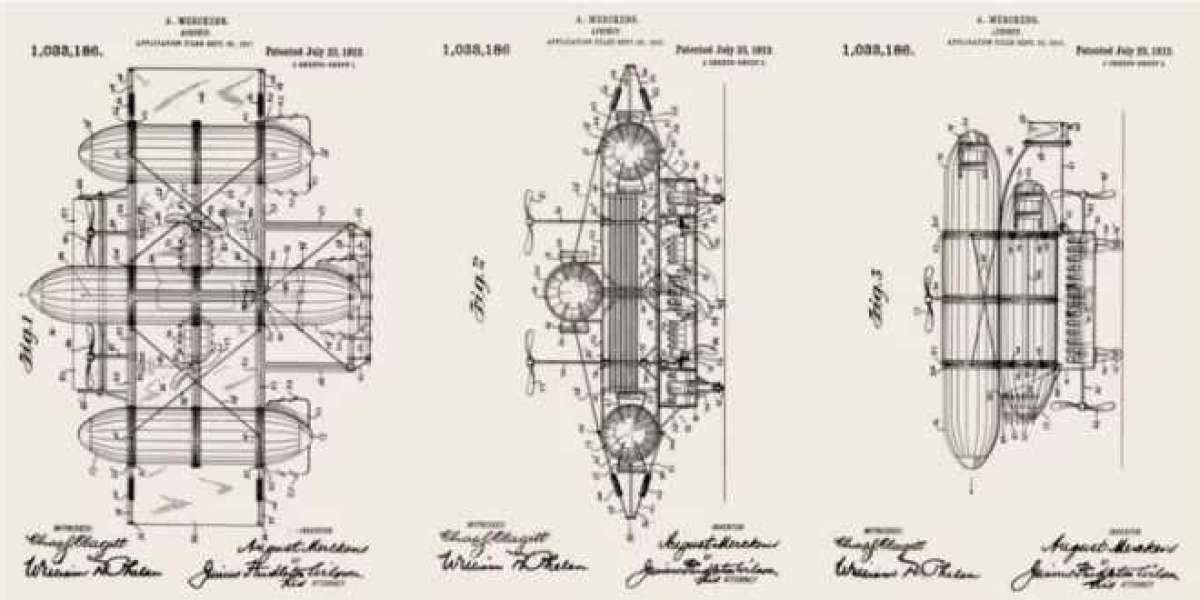Utility patent drawings play a pivotal role in the patent application process, serving as visual aids that provide a clear and comprehensive representation of your invention. These drawings are crucial for demonstrating the novel aspects and functionality of your invention to patent examiners. As you embark on the journey of securing a utility patent, you’ll inevitably face the question of whether to create your patent drawings yourself using software or enlist the services of professionals. In this comprehensive guide, we’ll delve into the factors that can influence your decision, helping you determine when it’s best to opt for DIY utility patent drawings and when professional services are the way to go.
The Importance of High-Quality Utility Patent Drawings
Utility patent drawings are often an overlooked yet indispensable aspect of the patent application process. These visual representations serve as a bridge between the written description of an invention and its real-world application. In this article, we will delve into the significance of high-quality utility patent drawings and why they are a crucial component of a successful patent application.
Enhancing Clarity and Understanding
One of the primary purposes of utility patent drawings is to enhance the clarity and understanding of your invention. While a well-written patent application can provide a detailed description of your innovation, visuals can often convey complex concepts more effectively. When patent examiners review your application, clear and accurate drawings can significantly improve their comprehension of your invention’s structure, function, and unique features.
1. Simplifying Complex Concepts
Innovations are often intricate and multifaceted, making it challenging to convey all the essential details through text alone. High-quality patent drawings simplify complex concepts, making it easier for examiners to grasp the essence of your invention.
2. Universal Language
Patent drawings serve as a universal language that transcends linguistic barriers. They allow patent offices worldwide to understand your invention, which is particularly advantageous if you intend to file for international patents.
Strengthening Patent Claims
Another critical role of utility patent drawings is to bolster your patent claims. Your claims define the scope of protection you seek for your invention. Well-crafted drawings can provide visual evidence that supports your claims, reinforcing your argument for patent approval.
1. Visual Evidence
When patent examiners see precise drawings that align with your claims, they can more readily accept your assertions regarding the novelty and uniqueness of your invention.
2. Overcoming Prior Art
High-quality patent drawings can help distinguish your invention from prior art (existing inventions) by illustrating the key differentiators. This visual evidence can be particularly compelling in proving the novelty of your creation.
Meeting Legal Requirements
Utility patent drawings must adhere to specific legal requirements set by patent offices. These requirements dictate aspects such as format, line thickness, and labeling. Ensuring that your drawings meet these standards is essential for a smooth patent application process.
1. Avoiding Rejections
Inaccurate or non-compliant drawings can lead to rejections or delays in the patent approval process. High-quality drawings that adhere to legal requirements help prevent these setbacks.
2. Consistency Across Applications
If you plan to file for patents in multiple jurisdictions, consistent, compliant drawings are essential to maintain the integrity and validity of your application.
Facilitating Collaboration
Utility patent drawings also play a role in facilitating collaboration between inventors, patent agents, and patent illustrators. Clear, detailed drawings can bridge communication gaps and ensure that everyone involved in the patent application process is on the same page.
1. Effective Communication
Accurate drawings allow inventors to effectively communicate their ideas and innovations to patent professionals, ensuring that the application accurately reflects the invention.
2. Streamlined Workflow
When the patent application process runs smoothly, it reduces the likelihood of errors, omissions, or misunderstandings that can lead to delays or rejections.
DIY Utility Patent Drawings Using Software
In the realm of intellectual property protection, securing a utility patent for your invention is a significant milestone. Part of the patent application process involves creating utility patent drawings, which serve as visual representations of your innovation. While many inventors opt for professional services to craft these drawings, a growing number are choosing the do-it-yourself (DIY) route using patent drawing software. In this comprehensive guide, we will explore the process of creating your utility patent drawings using software, along with tips and best practices to ensure your drawings meet the high standards required for a successful patent application.
Selecting the Right Software
Before diving into the drawing process, it’s essential to choose the right software for your needs. Here are some factors to consider when selecting patent drawing software:
- 1. Compatibility: Ensure the software is compatible with your operating system (Windows, macOS, etc.).
- 2. User-Friendliness: Look for software with an intuitive interface, as this will make the learning curve less steep.
- 3. Feature Set: Assess the software’s features, including drawing tools, templates, and export options. Ensure it meets patent office requirements.
- 4. Cost: Consider your budget. Some software options are free or offer trial versions, while others require a purchase.
- 5. Reviews and Recommendations: Research online reviews and seek recommendations from fellow inventors or professionals in your field.
Learning the Basics
Once you’ve selected your patent drawing software, it’s time to familiarize yourself with its basic functions and tools. Most patent drawing software packages include tutorials and guides to help you get started. Here are some fundamental aspects to learn:
1. Drawing Tools: Understand how to use drawing tools such as lines, shapes, text, and annotations to create precise and clear drawings.
2. Scaling: Learn how to scale your drawings accurately to meet patent office requirements. This typically involves setting the correct DPI (dots per inch) for your images.
3. Labeling: Know how to label different elements of your invention properly. Clear labeling is essential for patent examiners to understand your drawings.
4. File Formats: Familiarize yourself with the preferred file formats (e.g., TIFF, JPEG) for patent drawings and how to export your drawings in these formats.
Sketching Your Invention
With a solid understanding of the software, you can begin the process of sketching your invention. Keep the following tips in mind:
- 1. Start with Rough Sketches: Begin with rough drafts to outline the basic structure and components of your invention. These initial sketches can serve as a foundation for more detailed drawings.
- 2. Detail is Key: As you progress, focus on adding intricate details, dimensions, and any specific features that set your invention apart.
- 3. Consistency: Maintain consistency in line thickness, labeling, and style throughout your drawings to ensure a professional look.
- 4. Use Layers: Many drawing software tools offer layer functionality. Utilize layers to separate different components or versions of your drawings, making it easier to manage complex designs.
Review and Refinement
After creating your utility patent drawings, take the time to review and refine them. This step is crucial to ensure the quality and accuracy of your drawings:
- 1. Proofread Labels: Double-check all labels, annotations, and numeric data for accuracy and clarity.
- 2. Seek Feedback: If possible, have your drawings reviewed by peers or professionals with experience in patent drawings. They can provide valuable feedback.
- 3. Compare to Requirements: Compare your drawings to the specific requirements outlined by the patent office where you plan to file your application. Ensure your drawings meet these standards.
- 4. Revisions and Corrections: Make any necessary revisions or corrections to address any identified issues.
Professional Services for Utility Patent Drawings
In the pursuit of securing a utility patent for your innovative creation, every detail matters. One of the critical components of a successful patent application is the quality of your utility patent drawings. While some inventors opt for the do-it-yourself (DIY) approach using patent drawing software, others recognize the value of enlisting professional services. In this article, we will explore the benefits and advantages of turning to professional patent illustrators to craft your utility patent drawings, ensuring precision and efficiency in the application process.
The Expertise of Professional Patent Illustrators
Professional patent illustrators bring a wealth of experience and expertise to the table. Here’s why their knowledge matters:
- 1. Mastery of Patent Office Standards: Patent illustrators are well-versed in the specific requirements and standards set by patent offices. They understand the nuances that can make the difference between an approved patent and a rejection.
- 2. Technical Accuracy: Professionals possess the technical skills needed to accurately depict intricate details, dimensions, and complex features of their invention.
- 3. Efficient Workflow: Having a streamlined workflow, professionals can create utility patent drawings efficiently, saving you valuable time in the application process.
Precision and Clarity
Utility patent drawings demand precision and clarity, as they serve as visual evidence to support your patent claims. Professional patent illustrators excel in these areas:
- 1. Precision in Detail: Professionals pay meticulous attention to detail, ensuring that every element of your invention is accurately represented in the drawings.
- 2. Clarity of Presentation: Clear labels, annotations, and well-structured drawings make it easy for patent examiners to understand your invention without ambiguity.
- 3. Compliance with Standards: Professionals adhere strictly to patent office standards, eliminating the risk of application rejections due to non-compliance.
Meeting Tight Deadlines
In the world of patents, timing can be critical. Professional patent illustrators are skilled in working efficiently to meet tight deadlines:
- 1. Expedited Process: Professionals can significantly expedite the creation of your utility patent drawings, ensuring that your application is submitted promptly.
- 2. Focus on Core Tasks: By entrusting the drawings to experts, you can focus your energy and time on other essential aspects of your patent application, such as claims and legal requirements.
Collaboration and Communication
Professional patent illustrators often work in collaboration with inventors, patent agents, and attorneys, fostering effective communication and ensuring that your vision is accurately translated into drawings:
- 1. Clear Communication: Professionals are adept at understanding your requirements and translating them into precise drawings, minimizing the risk of misinterpretation.
- 2. Streamlined Workflow: Effective collaboration ensures that the patent application process runs smoothly, reducing the likelihood of errors, omissions, or misunderstandings.
- 3. Flexibility: Professionals can adapt to your needs, making revisions and adjustments as necessary to align with your evolving vision.
Cost Considerations
While professional services do come with a cost, they offer value by reducing the likelihood of errors, application rejections, and delays. Additionally, when weighing the cost of professional services against the potential economic benefits of securing a patent, the investment often proves worthwhile.
When to Use Software for DIY Utility Patent Drawings
The decision of whether to create your utility patent drawings using software or enlist professional services is a critical one in the patent application process. While professional services offer expertise and precision, there are situations where the do-it-yourself (DIY) approach using patent drawing software makes sense. In this article, we will explore scenarios in which creating your utility patent drawings with software is a practical and cost-effective choice.
Budget Constraints
For many inventors, budget constraints are a significant consideration. Here’s when using software for DIY utility patent drawings makes sense:
- 1. Limited Resources: If you have limited financial resources, investing in professional patent illustrators may not be feasible. Software often offers a more cost-effective solution.
- 2. Cost Control: With software, you have control over your expenses. You can choose from a range of software options, including free and paid versions, allowing you to manage costs according to your budget.
Simple Inventions
The complexity of your invention plays a crucial role in deciding whether to use software for DIY patent drawings:
- 1. Straightforward Inventions: If your invention is relatively simple and has few intricate details, creating your drawings with software can be manageable.
- 2. Minimal Technical Complexity: Inventions that do not involve complex mechanical, electrical, or technical components are well-suited for DIY drawings.
In-Depth Understanding
Your familiarity with patent drawing requirements and standards is a significant factor:
- 1. Knowledge of Standards: If you have a good understanding of the patent office standards and guidelines for utility patent drawings, you are better equipped to create compliant drawings using software.
- 2. Prior Experience: Prior experience in using patent drawing software or creating technical illustrations can give you a head start in the DIY process.
Time Availability
Time is another critical consideration. Here’s when creating DIY utility patent drawings with software makes sense in terms of time availability:
- 1. Flexible Schedule: If you have a flexible schedule and can allocate the necessary time to learn the software and create the drawings, DIY can be a practical choice.
- 2. No Urgent Deadlines: If your patent application timeline is not pressing, DIY allows you to work at your own pace.
When to Opt for Professional Services
Utility patent drawings are a critical component of a successful patent application, serving as visual evidence to support your claims. While some inventors choose the do-it-yourself (DIY) approach using patent drawing software, there are situations where enlisting professional services becomes the clear and prudent choice. In this article, we will explore the scenarios in which opting for professional services for your utility patent drawings is the best course of action.
Complex Inventions
Inventions with a high degree of complexity often benefit significantly from professional services:
- 1. Intricate Details: If your invention has intricate details, technical components, or complex mechanical structures, professional illustrators have the expertise to accurately depict these nuances.
- 2. Technical Expertise: Professional patent illustrators possess technical knowledge in various fields, allowing them to understand and represent even the most intricate inventions effectively.
- 3. Enhanced Accuracy: Complex inventions require precise and accurate drawings. Professional services can ensure that every detail is captured correctly.
Stringent Deadlines
In the world of patents, timing can be crucial. Consider professional services when:
- 1. Tight Timelines: If you have a pressing need to file your patent application within a short timeframe, professionals can expedite the drawing process, reducing the risk of missed deadlines.
- 2. Expedited Filing: In cases where expedited patent processing is necessary, professionals can ensure your drawings are ready promptly, aligning with the accelerated process.
Quality Assurance
Ensuring the highest quality and compliance with patent office standards is paramount. Choose professional services when:
- 1. Error Avoidance: Professional illustrators are less likely to make errors or omissions that could lead to patent application rejections or delays.
- 2. Compliance with Standards: Professionals adhere strictly to patent office standards, ensuring that your drawings meet all required criteria.
- 3. Reduction in Rejections: The accuracy and quality of professional drawings reduce the likelihood of your application being rejected due to non-compliance.
Focus on Core Tasks
Your time and energy are valuable resources in the patent application process. Opt for professional services when:
1. Focus on Claims: By outsourcing the drawing process, you can concentrate your efforts on formulating strong patent claims and addressing other legal requirements.
2. Complex Legal Aspects: If your invention involves complex legal considerations, such as international patents or multiple patent claims, professionals can help navigate these complexities.
3. Peace of Mind: Professional services provide peace of mind, knowing that an experienced team is handling a crucial aspect of your patent application.
Complex Collaboration
In cases where collaboration is essential and multiple stakeholders are involved, professional services can facilitate communication and ensure accuracy:
1. Effective Communication: Professional patent illustrators can effectively communicate with inventors, patent agents, and attorneys, reducing the risk of misinterpretation or misunderstanding.
2. Streamlined Workflow: Collaboration with professionals streamlines the patent application process, minimizing the chances of errors, omissions, or delays due to miscommunication.
Conclusion
In the realm of utility patent drawings, the choice between the do-it-yourself (DIY) approach using software and enlisting professional services is a decision that should be made with careful consideration. Both options have their merits and are suited to different circumstances, depending on factors such as budget, complexity of the invention, familiarity with patent office standards, time availability, and collaboration requirements.
For those with limited budgets, straightforward inventions, a strong understanding of patent drawing standards, and flexible schedules, DIY utility patent drawings using software can be a cost-effective and viable choice. It allows you to take control of the process and invest your time in learning and crafting precise drawings.
However, there are situations where the expertise, precision, and efficiency of professional services become essential. Complex inventions with intricate details, tight deadlines, a need for quality assurance, a focus on core patent tasks, and complex collaboration scenarios all point to the wisdom of enlisting professionals. Their mastery of patent office standards, technical accuracy, ability to meet deadlines, and experience in handling complex drawings can be invaluable in ensuring the success of your patent application.
Read More:
Unlocking the Power of Utility Design Patents: A Comprehensive Guide
The Role of Patent Draftsmanship in Intellectual Property Strategy
Mastering the Art of Patent Claims: The Heart of Your Patent








